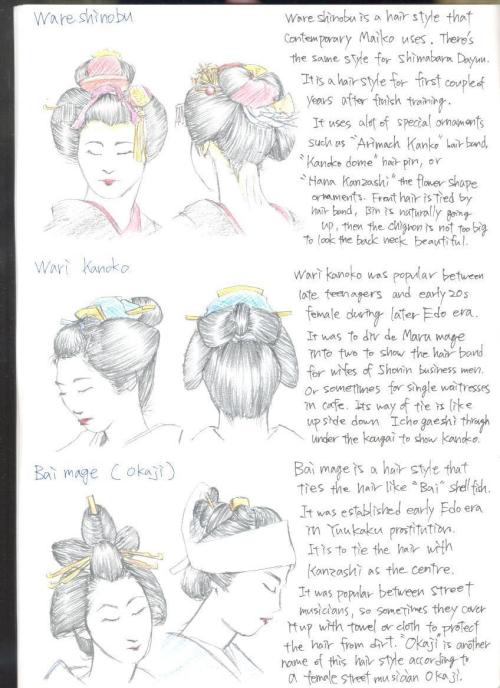Nihongami (Japanese hairstyles) - part 7/12: female styles, by Shota KotakeTabane gami variations (&
Nihongami (Japanese hairstyles) - part 7/12: female styles, by Shota KotakeTabane gami variations (½)Chigo Mage was a boy hairstyle used from Heian to Azuchi Momoyama eras. It started to be worn by girls during Edo era. For both girls and boys, topknot was tied into two big loops and usually didn’t use any ornament until early Taisho period. It was worn by 5 to 12 years old girls and was popular for working girls attending to princesses in palaces.Icho gaeshi is a Tabane gami variation of the Icho mage was worn by teenagers and women in their 20s. The icho mage was divided into looping halves and a nebake (hair cloth) was used to tie the topknot. A kanzashi was then pinned at its root.This hairstyle was also worn by Geisha and Taiyuu under their 30s during Meiji era. Momoware*** is a variation of Icho gaeshi which was worn by Chonin’s girls from late Edo era to Showa period. The front lock was slightly puffy and the nape chignon slimmer than in other styles. Topknot was divided into looping halves and tied with motoyui (paper thread, also called mizuhiki nowadays). An ornament was then usually pinned at the center. Momoware’s name is said to come from its chopped peach like shape. This style is now only seen worn by Maiko.Wareshinobu*** is worn by contemporary Maiko for their Misedashi. A similar style is also used by Shimabara Taiyu. This hairdo uses many special ornaments such as red Arimachi Kanko (?) tying the front lock, a Kanoko dome pinned at the topknot center and birabira+ tsumami kanzashi (hairpins). The side buns and slim chignon enhance the nape length, making Wareshinobu a very elegant style.Note: another distinctive element of this style are the silver strips named miokuri slipped in topknot back.Wari kanoko was popular among late teenagers and female in their early 20s during late Edo era. On a Maru mage base, a flatter topknot was divided by a lock to form a bow. In an upside down Icho gaeshi, a nebake (hair cloth, called kanoko when dappled) was tied on front and pinned with a kougai. This hairstyle was also worn by Chonin businessmen’s wives or single café waitresses.Bai mage (Okaji) name comes from its “bai” shellfish like shape, obtains by looping kanzashi pins at the center of rolls. It was used in Yuukaku (reserved prostitution area, like Yoshiwara) during early Edo era. This style was popular among street musicians, who used to cover it with a tenugui towel to protect their hairstyle from dirt. Okaji, a female street musician, gave this hairdo its nickname.***EDIT: @furisode-shoujo has shared some insight concerning Momoware and Wareshinobu hairstyles (thank you again :3):Hello. I really like the nihongami seires that you’re doing, but in the most recent post i noticed a mistake. Momoware is not worn by maiko, but by hangyoku. They are also apprentice geisha, but they are from Tokyo instead of Kyoto. (You can recognize them by the kouken musubi.) Wareshinobu is also not only worn for misedashi. It the hairstyle for junior maiko (2-3 year stage), but miokuri are only used only misedashi. It is also worn by minarai (1 month long stage before becoming maiko) -- source link
#nihongami#japan#references#ressources#drawing#heian#azuchi momoyama#meiji#taisho#maiko#geisha#taiyu#chonin#momoware#wareshinobu#furisodeshoujo

